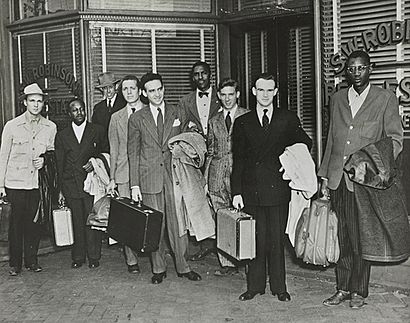Journey of Reconciliation facts for kids
Quick facts for kids Journey of Reconciliation |
|||
|---|---|---|---|
| Part of the Civil Rights Movement | |||
 |
|||
| Date | April 9 – 23, 1947 | ||
| Location | |||
| Resulted in | Inconclusive | ||
| Parties to the civil conflict | |||
|
|||
| Lead figures | |||
|
|||
| Arrests, etc | |||
|
|||
The Journey of Reconciliation was an important event in the Civil Rights Movement. It was also known as the "First Freedom Ride." This journey used a peaceful way to protest called nonviolent direct action. Its goal was to challenge unfair state laws that separated people by race on buses. These laws were common in the Southern United States.
Bayard Rustin and 18 other people organized this two-week journey. It started on April 9, 1947. The group began in Washington, D.C. They traveled south into North Carolina. Then, they returned to Washington, D.C. This journey later inspired the famous Freedom Rides that began in May 1961. James Peck, one of the white participants, also joined the 1961 Freedom Ride.
Contents
The Journey Begins
Sixteen men took part in the Journey of Reconciliation. Eight were white and eight were black. They were from an organization called the Congress of Racial Equality (CORE). The main organizers were George Houser, a white minister, and Bayard Rustin, a black Quaker. Both were also part of the Fellowship of Reconciliation (FOR). Rustin was also with the American Friends Service Committee.
Other black participants included Dennis Banks, Andrew Johnson, Conrad Lynn, Wallace Nelson, Eugene Stanley, William Worthy, and Nathan Wright. The other white participants were Louis Adams, Ernest Bromley, Joe Felmet, Homer Jack, James Peck, Worth Randle, and Igal Roodenko.
Traveling Through the South
The group planned to visit fifteen cities. These cities were in Virginia, North Carolina, Tennessee, and Kentucky. They started in Washington D.C. and went through Richmond. Their first stop was Petersburg. The next day, they traveled through Raleigh.
When they reached Durham, the bus driver called the police. This happened because Rustin refused to move to the back of the bus. The police did not do anything. The bus was delayed for 45 minutes while the driver and Rustin stood firm.
During the two-week trip, the African American participants continued to sit in the front. White participants sat in the back, or sometimes next to them. This was against the state laws at the time. These laws said that passengers had to sit separately based on their race.
Challenges and Arrests
The day after the incident with Rustin, the group met with a student council. They also attended church services. On April 13, four of the men were arrested. Two black men were arrested for not giving up their seats. Two white men were arrested for supporting them.
When James Peck went to pay their bail, a taxi driver hit him in the head. As the journey continued, racial tensions grew. Martin Watkins, a war veteran, was beaten by taxi drivers. This happened because he spoke to an African American woman at a bus stop.
After the Journey
In May 1947, the four men who were arrested went to court. They were sentenced and tried to appeal their sentences, but they did not win. On March 21, 1949, Rustin and the two white men went to court in Hillsborough. They were sent to segregated chain gangs. This meant they had to do forced labor in groups, separated by race.
Rustin wrote about his experiences in his journal. His writings and the actions of the "Journey" riders inspired later protests. These included Rosa Parks' famous protest in 1955. They also inspired the Freedom Rides of 1960–1961.
The riders were supported by a recent court decision. In 1946, the U.S. Supreme Court made a ruling in the case of Irene Morgan v. Commonwealth of Virginia. This ruling said that separating people by race on buses that traveled between states was against the Constitution. It said it put "an undue burden on commerce." However, the Southern states were not following this decision.
The protesters decided to limit their actions to the Upper South. This was because the risk of violence was lower there than in the Deep South. The riders faced several arrests, especially in North Carolina.
The NAACP and Thurgood Marshall had some concerns. They worried that direct protests might cause a lot of violence. They thought it might not lead to much progress for civil rights. However, the NAACP did offer some legal help to those who were arrested.
Bayard Rustin believed that the Journey of Reconciliation helped lead to another important court decision. This was the 1954 U.S. Supreme Court ruling in Brown v. Board of Education. That ruling said that segregated schools were unconstitutional. It ordered them to end.
See also
 In Spanish: Viaje de la reconciliación para niños
In Spanish: Viaje de la reconciliación para niños

